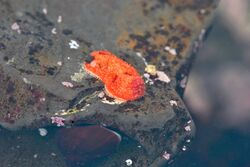Biology:Lissothuria nutriens
| Lissothuria nutriens | |
|---|---|

| |
| Dwarf sea cucumber clinging to a rock at the bottom of a tide pool | |
| Scientific classification | |
| Domain: | Eukaryota |
| Kingdom: | Animalia |
| Phylum: | Echinodermata |
| Class: | Holothuroidea |
| Order: | Dendrochirotida |
| Family: | Psolidae |
| Genus: | Lissothuria |
| Species: | L. nutriens
|
| Binomial name | |
| Lissothuria nutriens Brandt, 1835
| |
Lissothuria nutriens, commonly known as the dwarf sea cucumber or scarlet sea cucumber, is a bright red-orange sea cucumber that can be found in tide pools[1] along much of the California coast.[2]
Description
The dorsal surface is bright red-orange with small white tube feet evenly spread about. The lower surface or foot is pinkish and has rows of white tube feet.[1]:947 It grows to about 2 cm.[3] Surrounding its mouth, it has 2 small and 8 large pinkish red dendritic tentacles.[1]:942, 946–947 The flesh surrounding its mouth contains a few plates.[1]:947
Range
Lissothuria nutriens can be found from Monterey Bay to Southern California ,[1]:946–947 and have been found as far north as Point Arena-Stornetta Public Lands.[4]
Habitat
Lissothuria nutriens can be found clinging to or moving across a rocky substrate or in sandy areas between alga holdfasts from the low intertidal to 20 meters deep.[1]:946–947 Based on the observations on iNaturalist it can also be found on various kinds of alga.[5]
Diet
Lissothuria nutriens extends its sticky, dendritic tentacles[6] to catch plankton.[3] The tentacles then move the captured prey down its branches toward its base and into its mouth.[6] It absorbs additional nutrients that it extracts from mud.[3]
Reproduction
Lissothuria nutriens broods a small number of large eggs by moving them to pits on its dorsal surface.[1]:947 As a member of the order Dendrochirotida, the eggs have sufficient energy to enable the larvae to complete their development without needing to be fed.[6]
References
- ↑ 1.0 1.1 1.2 1.3 1.4 1.5 1.6 Abbott, Donald P (2007). The Light and Smith Manual [of] Intertidal Invertebrates from Central California to Oregon (4th ed.). Berkeley, Los Angeles, London: University of California Press.
- ↑ Miller, Allison K.; Kerr, Alexander M.; Paulay, Gustav; Reich, Mike; Wilson, Nerida G.; Carvajal, Jose I.; Rouse, Greg W. (June 2017). "Molecular phylogeny of extant Holothuroidea (Echinodermata)" (in en). Molecular Phylogenetics and Evolution 111: 110–131. doi:10.1016/j.ympev.2017.02.014. PMID 28263876.
- ↑ 3.0 3.1 3.2 Meerwasser-Lexikon Team (2016-12-21). "Lissothuria nutriens". https://www.reeflex.net/tiere/10264_Lissothuria_nutriens.htm.
- ↑ Young, Alison (2021-02-10). "Dwarf Sea Cucumber". https://www.inaturalist.org/observations/19369563.
- ↑ "Dwarf Sea Cucumber Photo Browser". 2021-02-10. https://www.inaturalist.org/taxa/49484-Lissothuria-nutriens/browse_photos.
- ↑ 6.0 6.1 6.2 Cannon, L.R.G.; Sliver, H.. "Order Dendrochirotida". http://species-identification.org/species.php?species_group=nasc&menuentry=groepen&id=17&tab=beschrijving.
Wikidata ☰ Q2491234 entry
 |

